#just why 😑😑
Text
So they bullied someone into deleting a harmless joke that wasn't even about charles (but they think it was slandering lecrec SOMEHOW) and they still don't understand why other F1 fans think theyre are toxic. Make it make sense
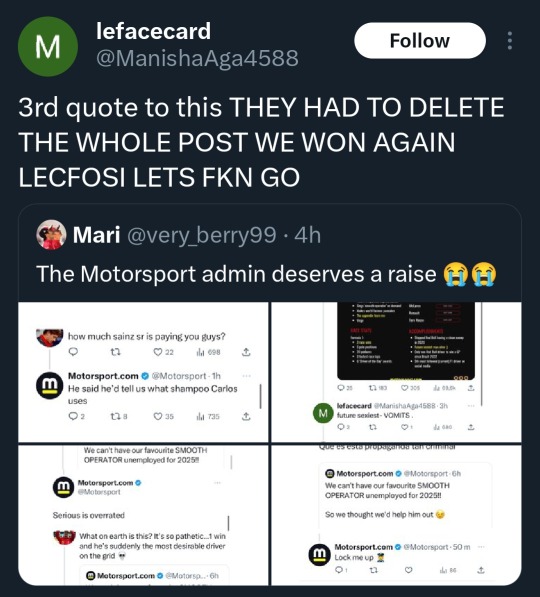
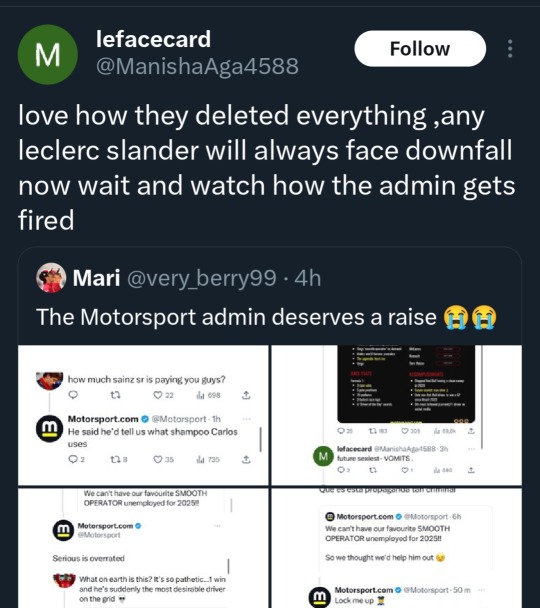
61 notes
·
View notes
Text

Oblivious
#the mandalorian#din djarin#luke skywalker#dinluke#leia organa#r2d2#don't worry din is just as oblivious#boba : why have u been gifting the jetti gifts??#din : to show gratitude for teaching grogu duh#boba : sight 😑
648 notes
·
View notes
Note
Oh yeah, Angel Dust has a sister, her name's Molly, there are a bunch of speed drawings with her.
Anon I think you are the only fan of Molly as I have not sent her be mentioned outside of 2017.
Genuinely thought that Molly was like Niffty/Vaggie situationship because I had NO fucking clue what stance Molly even was outside of just looking at a distant glance over definitely not realizing that was what happened to the past 'Angel Dust Drag'..... The fact that it personifies into a woman that is barely mentioned [much like angel representing or doing drag in the first place], turned into fucking THIS????
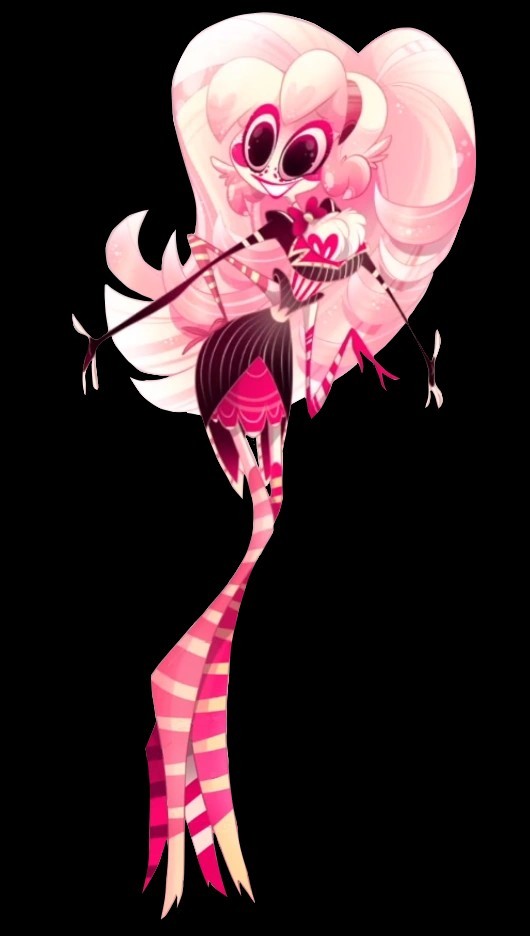

I cant even begin to comprehend.... She speaks for herself honestly. You can tell that viv genuinely did not give a fuck about the implications here or the lazy design that is 'Hmm angel dust but pink girly'

I feel like she just became cut content considering there hasn't ever been a mention about angels' family besides his Arackniss

Kinda weird how angel is more focused and put down upon in the spotlight more with Valentino and less with his 1930s mobster Italian spider persona :/ Even attempting to make a different womanly character known as the sister of angel dust, she is still tied down to him and has nothing besides this rainbow vomit old design.
How could I not be confused over angels' stance on dragging while VIV can't even fucking make characters up for him without retconning over herself!

You want this mess of a character design to be made but not Baxter???? I'm baffled. Thanks for bringing this horrid 'writing' decision to my notice. Since viv doesn't give a single lick of sense about Molly I too did not realize that Molly was supposed to be the hyper feminized pink eyesore that was SUPPOSED to be Angel's DRAG PERFORMING CARICATURE???
Your ask has the exact same amount of punch as telling me that Blitz has a sister, they are underwritten to be one of the same since they're women obviously Viv just doesn't like writing women ! :/
#also she looks like she wouldve been hell to animate :/#didnt even mention how turning a males DRAG QUEEN persona into an ACTUAL FEMALE REPRESENTATION is a horrible thing rlly#anti vivziepop#fucked up#trash askbox#helluva boss critical#hazbin hotel critical#anti spindlehorse#please stop supporting spindlehorse#thats like even worse that she was supposed to be his sister ugh 😑#she looks more coked out then the character NAMED angel DUST#still#there is no characterization or bite to angel outside of his drag sona#im just baffled over arackniss and cherry bomb having more spotlight then the fact that angel is a drag performer :/#i got into hazbin for angel dust because he made me realize i was transgender at a really low point in my life.#hence why the character USED to mean a lot to me alongside stolas but like wow im not excited over vivs' spark of hope for addiction#she can barely handle that stolas is a pill addict much less angel dust genuinely trying to kill himself through pleasures#vivziepop critical#please stop supporting vivziepop#spindlehorse critical#for a bit i thought they were the same fucking character#scopohobia tw#anti hazbin hotel#hazbin hotel criticism#leather with no mystique and lace with all the abuse blatantly written over :x
78 notes
·
View notes
Text
He just wants his chair, fluffy slippers, a good book and to be left alone in peace. But nooo..... Why couldn't he have been an only child?

#destiny of the endless#Destiny: Why can't they just leave me alone?#Death: Beacuse they're your little siblings#Destiny: I didn't ask for them#Dream drops a boat in his rose bushes... Heaves himself out of his big comfy chair... Ffs. 😑#Destiny: Dream get yout sh*t off my lawn and go to your room. I don't want hear excuses.. Room#The only person the twins will listen too#the sandman#the endless
238 notes
·
View notes
Text
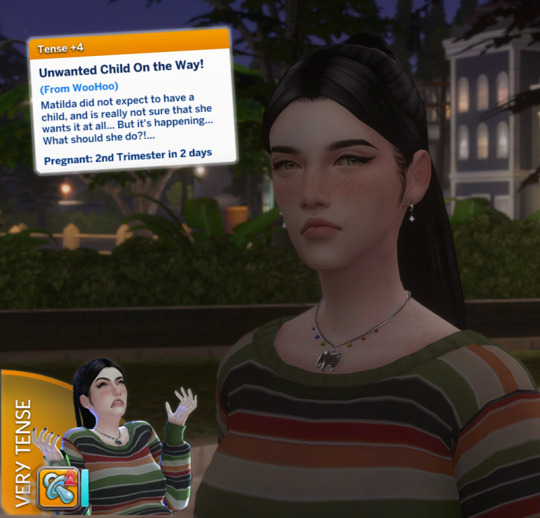
It's okay, Tilda.. just breathe 🧘♀️
#ts4#sims 4#matilda#fib extras#kkdjskdj#she PANICKING#idk why it says 'from woohoo' lmao.. cos it was definitely a science baby#we might not see it cos i cba but you can imagine cookie being all like AWWWWWH n' tilda's just sat there like 😑#ahahksjsd not everyone likes being preggers tilda it's fine#still proud of u#😘
121 notes
·
View notes
Text

*reading my fanfictions of him*
#it’s me pegging him#me: do you like it#he just#😑#why luver#why#what is wrong with you#me: so you love it#toshinori yagi#all might#bnha#mha#my hero academia#boku no hero academia
172 notes
·
View notes
Text
Guys! Yesterday I had a book-shaped piece of mail, and inside of it was my copy of Children and Childhoods in L.M. Montgomery: Continuing Conversations being returned, from another very dear user here! I bring this up only because some-months-ago I promised to copy out a particular article from this book, for yet another user here, who was interested! Interested because it’s on the the subject of a Fan Favourite thing... fan fiction. And better still because some of our (basically famous) mutuals here are mentioned by name! If you’ve ever wondered if the Montgomery scholarship is reading your fan fiction... the answer is yes, they are! They totally are. More than that, they also have some thoughts to share… as well as recommendations of their faves too! This article even covers the F/F and M/M fan fiction presented by fans in LMM’s universe, and I’m personally super excited to be able to begin reading these works, as soon as I can find them all. I’ve done my best to link what I could immediately find, but some of the mentioned stories were unavailable... potentially due to changes in usernames? (That said... if anyone knows of the works indicated here, that I haven’t provided a link for, please do share!)
This article, by the way, was written recently... in 2020! It’s very current, and it covers a few stories that were still being actively updated during the pandemic. The focus of this article is less so on canon (or really just the Anne/Gilbert pairing), though, and seems to prefer demonstrating the versatility of mixing relationships (Anne and Emily, for one!) and the wider more general universe-building aspects (the entanglements of future generations/Anne’s grandchildren) that fans have been expounding on for nothing less than decades.
Okay, here we go! xx
Continuing Stories: L.M. Montgomery and Fanfiction in the Digital Era by Balaka Basu
Fanfiction – the recreational (re)writing of texts – is a literary genre of rapidly growing significance. Abigail Derecho in her brief history of fanfiction identifies it as “a genre that has a long history of appealing to women and minorities, minorities, individuals on the cultural margins who used archontic writing as a means to express not only their narrative creativity, but their criticisms of social and political inequities as well.”
Insightfully defined by Francesca Coppa and Mary Ellen Curtin as “speculative fiction about character,” fanfiction can be even more precisely understood as fantasies about the diegetic positioning of characters in the context of various settings, communities, relationships both textual and paratextual, and eventually all manner of cultural mythologies.
Kristina Busse and Karen Hellekson describe the production of fanfiction as “part collaboration and part response to not only the source text, but also the cultural context within and outside the fannish community in which it is produced.”
They point out that the shift in the method of dissemination of fanfiction from newsletters and zines to internet archives means that “ever-younger fans who previously would not have had access to the fannish culture except through their parents can now enter the fan space effortlessly; financial resources have become less of a concern because access to a computer is the only prerequisite; and national boundaries and time zones have ceased to limit fannish interaction.”
The nature of fanfiction allows participants to cross-generational and socio-economic boundaries in an ongoing exchange of responses to a source text with which they share a fascination, developing new texts that in turn elicit their own responses. While the creation of fanfiction is evidence of an affective, loving, communal relationship with the source text, this genre of writing is still dismissed in many quarters as overly emotional, purely erotic, and even perverse, a type of amateur and immature engagement with popular texts that produces writing necessarily divorced from literary significance. Produced in staggeringly vast quantities by subcultures with complex vocabularies and traditions that can intimidate the casual reader, fanfiction is perceived by many to be more of a cultural practice than a literary genre, variously denigrated for its pornographic potential and its lack of originality. However, close examination reveals that fan writers are able to create a critical dialogue with the originating author in acts of communal storytelling that incorporate allusions and reference points to which other dedicated fan readers and writers may respond.
In this chapter, after examining how L.M. Montgomery and her writer heroine Emily themselves engage in practices now associated with fanfiction, I survey four forms of fanfiction that remove Montgomery’s novels from her seemingly idyllic and timeless island settings, contextualizing her characters and plots within history and other genres: the sequel set during the Second World War, the modern AU (alternate universe), the gap-filler, and the slash fic, all of which allow the young readers who grow up with her novels to engage in dialogue with the stories they love, a type of literary conversation that Montgomery herself models within her texts. Emily’s reading, which is active rather than passive, resembles twenty-first-century fans’ ownership of the texts they love, provoking creative responses. For instance, after reading works by Lord Tennyson, Elizabeth Barrett Browning, and Matthew Arnold, Emily writes, “Teddy lent me 3 books of poetry. One of them was Tennyson and I have learned The Bugle Song off by heart so I will always have it. One was Mrs. Browning. She is lovely. I would like to meet her. I suppose I will when I die but that may be a long time away. The other was just one poem called Sohrab and Rustum. After I went to bed I cried over it. Aunt Elizabeth said ‘what are you sniffling about?’ I wasn’t sniffling – I was weeping sore … I couldn’t go to sleep until I had thought out a different end for it – a happy one.”
The reactions Emily catalogues are those of the fan; they are viscerally felt in the body and attempt to dissolve the boundary between author and reader, producer and consumer. She inscribes Tennyson within her heart in order to possess the poem she loves; she creates a relationship between Barrett Browning and herself; and, most significantly, she interjects her own desired happy ending into Arnold’s tragic narrative, a corrective desire that is at the core of many works of fanfiction. Emily’s diaries and her story reflect Montgomery’s own experiences from childhood to adulthood as reader, writer, and reader-turned-writer discussed in the introduction to this volume. Depicting Emily as a voracious reader and a life-writer like herself, Montgomery places the child Emily’s voice in conversation with that of the narrator through Emily’s letters to her dead father in Emily of New Moon and through her diary entries in Emily Climbs and Emily’s Quest, creating a form of joint authorship that is referenced explicitly in “Salad Days,” the second chapter of Emily Climbs: “book is not going to be wholly, or even mainly, made up of extracts from Emily’s diary; but, by way of linking up matters unimportant enough for a chapter in themselves, and yet necessary for a proper understanding of her personality and environment, I am going to include some more of them. Besides, when one has material ready to hand, why not use it?”
The narrator’s willingness to use the “material” that is “ready to hand” reflects Montgomery’s and Emily’s practices, and also validates other writers’ use of the material Montgomery places at their disposal. As with many fans, Emily’s reading frequently makes itself felt within her writing.
Like Montgomery, Emily learns her trade through mimicry, from her first poem in blank verse inspired by James Thomson’s Seasons to her unwitting imitation of Kipling that is pointed out by her teacher, Mr Carpenter, in his review of her work. Like Sara Stanley of The Story Girl, whose compelling and fascinating stories are rarely if ever original, Emily is a fan of the oral traditions of her community, incorporating and building upon them in her own writing, transforming and recreating, for instance, the story of “The Woman Who Spanked the King” in Emily Climbs.
The retelling and versioning that Emily practises signal her immense admiration for the source texts she adapts, just as the creation of fanfiction does for Montgomery’s readership and fans. The possibilities inherent in versioning and adaptation are illustrated in Emily’s Quest. When Montgomery depicts Emily undertaking the reworking of someone else’s narrative, she is adapting an episode from her own experience while working for The Echo in Halifax, which she records in her journal. Montgomery, like Emily, was asked to create an ending for a serialized story, “A Royal Betrothal,” after compositors had misplaced the original text.
Like Emily, she claims that her “knowledge of royal love affairs [was] limited,” and that she was unaccustomed “to write with flippant levity of kings and queens.” Nevertheless, Montgomery manages to create a conclusion that passes muster, since “as yet nobody has guessed where the ‘seam’ comes in.” She is, however, curious about the original author’s reaction to her unauthorized adaptation, and while she never discovers this in real life, she does imagine it in her fiction when she introduces Mark Greaves, who is horrified by Emily’s new ending for the story but enchanted by its author. Neither Montgomery nor Emily engages in this sort of writing from a place of fandom; they have no previous attachment to “A Royal Betrothal,” and both are writing professionally. Nevertheless, the ability to solve the puzzle of the story and the weaving of their work into an already extant text are the very project of fanfiction: ludic narrative composition that recalls the way children play make-believe with the narratives they love, reworking and extending them. It is telling that Montgomery uses the metaphor of the “seam” to describe this particular craft. Jane Dawkins, writing about her fanfiction, which is inspired by Jane Austen, describes her fan novel Letters from Pemberley as “an old-fashioned patchwork quilt, where in place of the scraps of fabric reminding one of the favorite frocks or shirts whence they came, there is a line or a phrase or a sentence from one of [the original] books or letters stitched alongside the lesser scraps of my own manufacture.”
Montgomery’s final book, framed by the two world wars, is just such a patchwork sequel, albeit providing only brief glimpses of the characters that readers met as children and who have now grown older. When a version of the book was published in 1974 as The Road to Yesterday, these glimpses, lacking the interstitial materials, became even briefer, mirroring the more forced insertion of beloved characters that the two earlier collections, Chronicles of Avonlea and Further Chronicles of Avonlea, display. Only two of Anne’s grandchildren – Gilbert Ford and Walter Blythe – are obliquely referred to, in the story “A Commonplace Woman,” where an unpleasant young doctor reflects on both of them as potential rivals for the affection of a beautiful girl he himself hopes to pursue.
However, the full novel, The Blythes Are Quoted, published in 2009 and comprised of short stories about the people in Glen St Mary and over the harbour, is interspersed with poetry by both a young Walter and an adult Anne. The poems are cut with tiny slices of dialogue that suggest the continuing lives of fans’ favourite characters and how they might have developed. In “‘Dragged at Anne’s Chariot Wheels’: L.M. Montgomery and the Sequels to Anne of Green Gables,” Carole Gerson notes the mixture of feelings from pleasure to frustration that Montgomery records in her journals as she prepares to write her first sequel.
While Montgomery wrote the first installments of her various series out of inspiration, she was certainly aware of what her market desired from subsequent installments. She often regretted the necessity of marrying off her characters, but was aware that her fans demanded this conventional outcome for the characters they had come to love; these traditionally romantic endings, when not offered by Montgomery herself at the instigation of her publishers, are regularly deployed by contemporary fanfiction authors building on the source texts.
Indeed, long before the original structure of The Blythes Are Quoted was revealed to readers in Benjamin Lefebvre’s afterword, fanfiction writers were spinning off lengthy narratives that included a third generation of young Blythes, Fords, and Merediths dealing with the onslaught of the Second World War. While earlier installments in the Anne series – such as Anne of Green Gables and Anne’s House of Dreams – depict the deaths of Matthew, Anne and Gilbert’s first daughter (Joyce), and Captain Jim, Walter’s death in Rilla of Ingleside is somehow more striking. Unlike Matthew and Captain Jim, he has not yet had time to grow old; unlike Joyce, readers have had opportunities to get to know him as a child in Rainbow Valley and as he grows into young adulthood in Rilla of Ingleside. His death is unnatural and, therefore, all the more horrifying. These two aspects of Rilla of Ingleside – the evocation of history by a nostalgic fictional world that is still tied to real time and the use of high drama, tragedy, and romance – provide fanfiction authors with a model they can use to appeal to the emotions of those readers who are immersed in the next generation of Montgomery characters.
The Second World War, then, provides an entry point into the series for fanfiction authors, who can deploy real history coupled with beloved characters to create a tale that feels absolutely authentic. One example of this is a short story, “The Pen and the Sword,” written in 2007 by MarnaNightingale. Here, mimicking the style of Dorothy L. Sayers’s The Wimsey Papers (a series of Spectator articles published between 1939 and 1940, which interestingly also continue the story of First World War–era characters during the Second World War), MarnaNightingale employs epistolary excerpts and newspaper articles to tell the story of a family going through the horrors of war for a second time. Grounding her fragmented story – like The Blythes Are Quoted, a mixture of genres – in the accounts of novelist Mollie Panter-Downes (1939) and war correspondents Ernie Pyle (1940) and Ross Munro of the Canadian Press (1941), whose articles are attributed to Kenneth Ford, she offers a story that, like Rilla of Ingleside, is anchored to the historical moment, while also nostalgically focusing on the character development that comes from Gilbert Ford’s death, Rilla’s and Faith’s reactions to the war, and the lives of their children. Here war also serves as an opportunity for new experiences, particularly for women and children: Rilla takes a factory job as a machinist, liking it better than working in Carter Flagg’s store; one of Anne’s grandchildren, Susan, plans to be a doctor; and Faith, who worked as a Voluntary Aid Detachment nurse in the First World War, mentions how she can sympathize. As well, the daily tidbits that flavour the pages of Rilla of Ingleside are there: one article, attributed to Anne, includes the recipe for Susan Baker’s war bread, reminding readers of the problems of wartime rationing, even in the Americas. Real life events – like the Canadian forces trying (and failing) to make a beachhead at Dieppe – arouse the passions of the reader. Unlike Austen – who also famously wrote of three or four families in a country town, but kept the Napoleonic wars firmly in the shadows – Montgomery brings the passions and high drama of the world stage into the sleepy villages of Prince Edward Island, which inspire fanfiction spinoffs.
The long novel Cecilia of Red Apple Farm, by a fan author who posts under the pseudonym ruby gillis, also directly reworks passages and scenes from the whole range of Anne books, set in the late-nineteenth century, to The Blythes Are Quoted, set in the early years of the Second World War, to highlight the similarity between her new generation of characters and their ancestors. Cecilia is the daughter of Una Meredith and Shirley Blythe (characters often married off in fanfiction). Like MarnaNightingale, ruby gillis provides period flavouring in the styles of dresses and behaviour and in references to 1940s popular films and songs. Simultaneously, this setting offers new opportunities to her female character: Cecilia wants to be a doctor, and rather than staying in Canada, she joins up to be a nurse in England. She has a series of romances – one with Sid Gardiner (before he marries May Binnie), and one with her cousin Blythe Meredith, who is this generation’s poet – before finally ending up with Marshall Douglas (the son of Mary Vance). Just as Anne initially refuses Gilbert Blythe in favour of Roy Gardner’s resemblance to her ideal man in Anne of the Island, ruby gillis’s Cecilia is fooled by the allure of Sid and Blythe as Roy Gardner–like romantic heroes into believing that she does not truly love her fun, practical, “Gilbert-esque” friend. Published in 2004, Cecilia of Red Apple Farm further illustrates the opportunities presented by reusing and reworking a body of texts through its incorporation of Montgomery’s poem “I Wish You” as the work of Blythe Meredith. Montgomery includes this poem and attributes it to Anne in The Blythes Are Quoted, although ruby gillis could not have known this when writing. The repetition of names and circumstances might seem derivative, but for readers who have read and reread the original books so many times, the extension of the story world is prized, even if – perhaps even because of – its callbacks to the original text. Due to the tendency of fans to fixate on “the good bits” in a reread, these parts can be taken for the whole.
Austen fanfiction demonstrates this aptly. Indeed, Helen Fielding’s second Bridget Jones novel, Bridget Jones and the Edge of Reason (1999), illustrates just such a reading of Pride and Prejudice: she shows Bridget, a fan, watching the scene from the 1995 mini-series in which Darcy, dripping in a wet see-through shirt, exits the lake, and then rewinding and rewatching the scene multiple times. How many times might a similar fan reread Walter’s letter from Courcelette? This repeated reviewing of selected portions can replace the amplitude of the original novel. With this delimited focus, narrative is no longer seen as a progression, but as a single moment of pleasure, sustained as long as possible. Reading the Second World War as a repetitive sequel to the First World War further highlights this possibility.
Even Montgomery seems to do so, as demonstrated in The Blythes Are Quoted, with its new generation of characters confusingly named after the old: Walter, Jem, Rilla, Di, Anne, and Gilbert. A variation on Marah Gubar’s kinship model, this kind of continuation highlights the blurred boundaries between child and adult characters who are literally related to one another and whose adventures mimic one another.
In a third example of fanfiction set during the Second World War, Weeping May Tarry, a long novel by ElouiseBates, Meggie, the heroine, is Shirley’s daughter (and also, surprisingly, Paul Irving’s granddaughter). In this story, which like Cecilia of Red Apple Farm is an installment of a longer series, Meggie is sent off to a conservatory of music to study singing, aptly combining the traditions of the nostalgic boarding-school novel with “Girl’s Own” wartime fiction. Following the tradition of Magic for Marigold, which explicitly suggests in its second chapter that the Murrays of Blair Water and the Lesleys of Cloud of Spruce exist in the same universe, @e-louise-bates (like many other fanfiction authors, including ruby gillis) suggests that all of Montgomery’s characters exist in a single universe: Meggie partners briefly with the grandson of Sara Stanley (The Story Girl and The Golden Road) and is close friends with Jane Stuart (Jane of Lantern Hill).
Going even further, @e-louise-bates introduces the grandchildren of the What Katy Did series as friends for Meggie and includes Betsy from Dorothy Canfield Fisher’s Understood Betsy as Bruce Meredith’s wife, creating a world where all the characters of early-twentieth-century girls’ fiction seem to have truly lived, where their descendants must cope with victory gardens and dances with soldiers at the Exhibition Grounds, and where kisses are much more commonplace than they once were.
These particular continuers of Montgomery are also desirous of membership in the community of her fans, seeing their literary endeavours as productive of approval from a fellow readership. Likewise, the novels are notable for their sociality – they seem to offer the reader not only a fantasy friendship with the characters themselves but also the very real society of fellow readers of the works. Thus, these fan authors attempt to diversify their stories so that they represent contemporary beliefs regarding multiculturalism; ruby gillis, for instance, introduces into the family by way of marriage a French girl who has had to flee the Nazis due to being Jewish, a situation Montgomery and her contemporaries might have had some difficulty accepting, considering early-twentieth-century attitudes toward interreligious marriage and Montgomery’s othering of the German-Jewish peddler who sells Anne green hair dye.
The Second World War thus offers writers of Montgomery fanfiction the loom on which to weave new, more diverse stories, even as The Blythes Are Quoted, which also traces the characters’ reactions to this new war, demonstrates how these readers-turned-writers followed Montgomery’s own trajectory, not knowing that they were doing so. On the subject of fanfiction, young-adult author Patricia C. Wrede writes: “The thing that fascinates me about fanfiction, though, is the way that it models the decision tree that writers go through (whether consciously or unconsciously) to get to their final product. For those of us who do this part mostly unconsciously, it can be interesting and instructing to see the multitude of alternate paths that a story could have taken, all laid out more-or-less neatly in different authors’ fanfics [… taking a slightly different fork in the road] resulting in the plot veering in a completely new direction. Friends become enemies; enemies become friends; goals and objectives and results shift and change.” Within these pieces of fanfiction, then, fan writers are able to follow these decision trees with subsequent generations of characters as well.
Another avenue of access occurs when fan authors transpose historical narratives into the contemporary moment. Perhaps the best-known example of this modern alternate universe [AU] conversion is the television program Sherlock, which takes Arthur Conan Doyle’s Victorian detective into the twenty-first century. While new cultural contexts appear, the essence of character is meant to be retained. Just as Sherlock uses text messages and blogs to substitute for telegraphs and handwritten journals, fans of Montgomery reimagine the relationships between her characters as if they were taking place online.
For instance, “Work in Progress” (2012) by verity postulates a friendship between Montgomery’s most famous heroines, Anne and Emily. In this piece of fanfiction, Emily circumvents Aunt Elizabeth’s injunction against fiction during her time at Shrewsbury High by becoming a blogger who is restricted to the “truth.” The story’s online summary, a part of which reads “Anne rolls her eyes. ‘Is your aunt really going to know if you cheat on your nonfiction with some hot prose on the side?’” shows how the story preserves the character qualities that Montgomery laid out, complete with references to the Murray pride and Anne’s orphanhood. Mr Carpenter’s admonitions are spelled out at the beginning of the story:
“Emily Byrd Starr has a sticky note on her desktop. It reads:
ITALICS
CAPITALS
!!!!!
“just”
“really”
CTRL+F!
It is almost like having Mr Carpenter in the room with her.”
Verity creates humour through the juxtaposition of contemporary social media and allusions to Montgomery’s source text. Another story by verity detailing Rilla’s romance with Ken Ford and her friendship with Una Meredith, “Rilla of Toronto,” takes place mainly through instant messages. In this story, Rilla reflects on her life from eighteen to twenty-five, tracing a continuum from her child self to her new adulthood, underscored by verity’s translation of Montgomery’s work into contemporary millennial language.
A third type of fanfiction narrative, the gap-filler, focuses on and expands the implications of the source texts. Moira Walley-Beckett’s Netflix/CBC series Anne with an “E,” as Laura Robinson shows in chapter 12 of this volume, is somewhat fanfictional in and of itself: as Robinson points out, the show fills gaps by bringing to the fore the darker currents that have always been beneath the seemingly untroubled waters of Anne of Green Gables, including Anne’s potential post-traumatic stress disorder from the disturbing life she led before coming to Green Gables. This kind of versioning and adaptation tacitly permits fan authors to feel that their versions are just as valid as those produced by professionals. Gap-fillers frequently expand on romantic pairings and in fandom are often referred to by portmanteaux of characters’ names that perpetuate some inside joke or work as puns. “Shirbert” – a moniker for Anne and Gilbert – is the latter, and demonstrates how fans posting on sites like Archive of Our Own (Ao3), Fanfiction.net, and Wattpad (this last generally populated by younger fans) develop their own language to identify their stories within the community for which they write.
One such story, “You caught me staring, but I caught you staring back,” by Anuka, clearly inspired more by the television series than the novels, begins with an author’s note that reads, “I decided to write some fluff for these two, because I need more Shirbert moments, and season 2 is so far away. I added gifs to make it more vivid.” Here, the romance between Anne and Gilbert as depicted by Montgomery and Walley-Beckett is not sufficient for the reader-turned-writer. Anuka wants the gaps in the narrative to be more fully explored than they are on either page or screen and to be made more “vivid” by the inclusion of images that help make the story come alive.
Similarly, “Rilla Blythe’s Wedding: A Not Entirely Comprehensive Account” by Scylla also fills a gap: Rilla and Ken’s wedding day, a scene that Montgomery leaves to the reader’s imagination at the end of Rilla of Ingleside. Modelled upon other accounts of weddings within Montgomery’s fiction, the story also suggests that accounts of Walter’s death have been gravely exaggerated, as he makes a stunning appearance at his sister’s wedding. In order to align her work with Montgomery’s novel, Scylla ensures that Little Dog Monday’s awareness of Walter’s death remains, but makes it only a technicality, writing, “His heart had stopped for a full ten seconds – long enough for his Captain to feel for his empty pulse and for Dog Monday to be jolted with the fullness of his death. Little dogs, after all, can only have tender dogs’ hearts. Grief to Dog Monday was an all-consuming thing, and when Walter’s heart began to beat once more, he was deaf to its spark of joy.” After meeting with his eldest sister, Joyce, in heaven – which is, as he had always hoped, Rainbow Valley, Walter is returned to life so that he may write of peace as well as war (as he did when he was a boy), marry Una, and repair the broken hearts of readers who did not want to lose him.
While heterosexual pairings are the most prevalent in Montgomery fandom, there is room for queer imaginings as well.
This very popular genre of fanfiction, known as “slash,” is generally defined as stories that centre on samesex romances between characters, particularly between men. Montgomery slash fiction usually stars Walter Blythe.
One slash story, “but i don’t know who you are” by @freyafrida, imagines a bisexual Walter. Told in an enduringly popular sub-genre of fanfiction often referred to as Five Things Plus One (which involves a series of thematically linked but not necessarily chronological scenes), the story is summarized by @freyafrida as “Five people Walter thought he wanted, and one person he didn’t notice until it was too late.”
This last person is original to Montgomery’s text: Una, whose apparently unreturned attraction to Walter is woven through Rilla of Ingleside. The other five potential partners are all alluded to as Walter’s close friends, beginning in childhood with Alice Parker from Anne of Ingleside and Pat Brewster from The Blythes Are Quoted and then carrying on through adolescence and young adulthood with Faith Meredith, Ken Ford, and finally Paul Irving from Anne of Avonlea. While his feelings for Faith and Ken are clearly unrequited, Alice, Pat, and Paul all express their own desire for Walter. The inclusion of the famous poet and Walter’s “model” uncle, Paul Irving, in particular, particular, illustrates how traits of sensitivity and aesthetic appreciation that challenge traditional ideas about masculinity are frequently interpreted as queer by fan readers and writers.
In another slash fiction, cero_ate’s “The Moving Finger Writes, and Having Writ Moves On,” Walter discovers his homosexuality while fighting in Europe:
He wrote half truths and lies once more, when he wrote his Rilla that he could not form poems of the depths of the war. For who could write his sister of the phallic love he had found? He had found his reason in a tow-headed American boy. He meant so much more to Walter than mere friendship could explain. He wanted to write, as sweethearts write, of the tempest of joy in the darkest night. But how would they understand? How would they even try to understand he sought not the Dark Lady of Shakespeare but the youth, fair and Wilde? When he was presented with Una’s faithful heart, he spurned it. When his tow-headed darling presented his own, Walter took it, greedy for him. His grecian style love, the boy who’s [sic] eyes danced, even in the darkest of days. He would do anything to keep him safe. But he could not present him to his family, for their scorn or pity. War had broken him, but made him as well.
While male/male pairings are generally the most popular stories in fandoms, Montgomery’s novels, peopled as they are by communities of girls and women, require that readers who want to queer the text must explore what is called femslash (that is, slash fiction featuring two female characters).
Such relationships have been explored within the academic setting. For instance, Laura Robinson remarks in “Bosom Friends: Lesbian Desire and the Anne Books,” that the relationship between Anne and Diana uses “the language that readers associate with adult romantic love rather than girlhood affections,” even as it is expressed through the heterosexual paradigm of marriage.
One fanfiction author, ArcticLava21, makes it clear that such fan written stories are not speculation but instead address key issues of representation. The author’s note to ArcticLava21’s short Anne/Diana story, “Nature,” reads, “Hello everybody! Hope your [sic] having a wonderful day. Before anyone yells at me for ‘sexualizing platonic friendships’ please note that this is for all those queer kids who grew up pretending. Pretending that he ended up with him instead of her, or desperately wanted representation. Are we good? <3 Enjoy yourselves lovely people.” The intended audience of the story, “queer kids who grew up,” again establishes the transgenerational kinship between Montgomery’s child and adult fans.
All fan fiction, shared on the Internet, exist in dialogue not just with Montgomery’s fiction but with the author herself, and between the fans who read the novels as children and adolescents and the adults that these readers become.
Whether fan writers extend the narrative or fill gaps, transpose chronology or to queer the text, these pieces of fanfiction allow fans not only to insert themselves into the narrative, but also simultaneously to revivify the original novels, published a century ago. In performing interventions to the text, Montgomery’s young fans grow up to reply to the discussions that she began long ago in the pages of her journals and stories, ensuring that all three – author, reader, and text – are continually reborn into a conversation that will never end.
#any typos here are all mine 😑#apologies because i’m sure there’s so many… i’m just bleary-eyed from the screen time it took to type this guy up!#like#why didn’t i just get the kindle version#lucy maud montgomery#fan fiction#anne of green gables#emily of new moon#too many individually referenced characters to tag here really!
21 notes
·
View notes
Text
*opens the sam wilson tag*


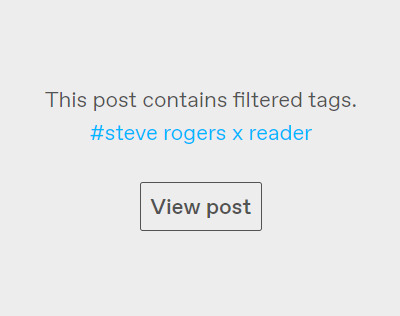



#why why why why#look it’s. whatever I really don’t give a shit do your thing#but tell me WHY these are more than HALF the TOP posts in the SAM WILSON TAG. the *SAM WILSON* tag!#and then another quarter is about stucky completely unrelated to sam. don't make me hate on stucky y'all come on#🚬🚬😑#I feel like I could go into a whole fucking analysis here but better ppl than me have put it into words. I’m just so so tired#he deserves better!! he deserves better.#sam wilson
24 notes
·
View notes
Text
has anyone on here mentioned hyuna is possibly dating yong junhyung, former member of highlight who was involved in the burning sun scandal? bc i havent seen it around here yet
#saw she was tending in twitter as was excited until i saw why 😑#also i say Possibly bc she just posted a pic of them holding hands on insta. there wasn’t a statement or anything#even still….hyuna what the fuck#🎆.txt
41 notes
·
View notes
Text

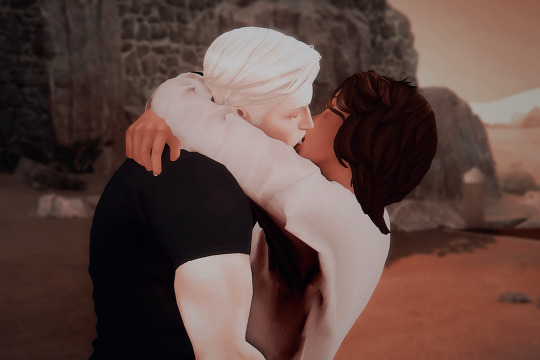
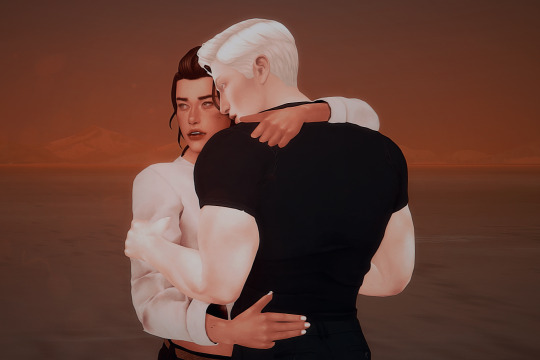
we're just gonna ignore how theo's hands clip wherever he touches matthias's upper body at in favor of looking at how pretty they are
#such cute poses but if theo touches matthias anywhere but his face it's OVER#god................... so do you SEE why i had to just start making my own poses??#don't pay attention to the weird shading theo's top has btw... i was saying to olli yesterday that the shirt is only nice from the front 😑#river dipping#ts4#matthias evanoff#theodore doe#a burning house to live in#echthroi#these are more of the extras from that last ask if you can't tell.......#oh and can you ALSO see why i had to go and make my own presets for gshade??? with matthias being this pale just imagine what#it'd look like if i were to have switched to someone else's preset while taking these pics....... blinded instantly.#bloom 100%. my retinas DESTROYED. would've been so bright i would start hearing colors.#did i delete that old post were i turned on someone else's preset just for fun and matthias was literally just a ball of light...#hang on
93 notes
·
View notes
Text
sorry this is so specific and self-indulgent and came out of nowhere but i blame @smr7k4 for this anyway supernatural au where scorpius is a washed up curse researcher/scientist who used to be trying to fine-tune or alter curses that are already incurable to work in favour of wizardkind which was a motivated passion after his mum died from one. he was recording how this one ritual could bring back people from death permanently outside of the resurrection stone but something went horribly wrong in his experiment. so scorpius let his research and projects get disbanded bcuz it crossed the border between normal magic and dark magic.
fast forward and scorpius dies somehow. his husband doesnt share nearly the same amount of moral limitation that scorpius subjected himself to, and would do just about anything to get him back. albus goes fishing around for all of scorpius’ old notebooks until he finds that ritual with the specific curse. he performs it and boom he got a little cannibal zombie hubby now. but zombo!scorp also needs to live on human meat so albus becomes a serial killer so he can sustain scorpius (who also isn’t very conscious of his actions and is in a state of animalistic bloodlust, but for some reason still holds a soft spot for albus). meanwhile rose would be the detective auror thats hot on albus’ trail trying to figure out who is responsible for the random killings.
essentially the au is albus finishing scorpius’ research by trying to figure out how to make him more human. he’s documenting what kind of foods zombo!scorp can and cant eat, how to restart all parts of his body to get it functioning again, how to help him access memories to his life and vice versa.
“oh blood type A- gives scorpius tummy aches so i won’t feed him people with that type” then jots down scorp’s lactose intolerant like symptoms. “oh scorpius doesnt like eating hair he always just eats around it. it would be easier if i just remove that part of the head” then takes note of scorpius’ preferences like its cutting crust of bread. “ugh rose is being annoyingly smart again looks like i gotta frame someone to buy me some time before she finds me out sighhh” or “scorpius was always such a sweet tooth so maybe i need to find people with high glucose levels” or “maybe if he eats someone familiar like karl jenkins or something that could trigger a memory for him and reverse some of these effects” (albus just wants an excuse to murk karl).
#bcuz scorpius is smart enough to be the mad scientist but he’s too moral 🙄#on the other hand. albus wins the idgaf war#he probably renovated the whole basement so it could be scorpius’ zombie lair. zombie scorp doesn’t appreciate it but he will 🙄#anyways the ending is either scorp turns human again or they both become zombie husbands bcuz. they need to be together no matter wut#he just wants scorpius in any form he doesnt care if he’s literally rotting with his ears falling off#when scorpius gains conciousness again he is horrified about how BAD he smells. he’s like i need a rose-scented bath RIGHT NEOW 😾#‘albus!! why would u have me looking like this! 😠’ ‘bcuz if i got too close you would try to bite me 😑’#harry potter#hp#hpcc#cursed child#scorpius malfoy#albus severus potter#scorbus#albus potter#rose granger weasley#rgw tag#karl jenkins#hpng#hp nextgen#hp next gen#harry potter and the cursed child#hp starlight#starlight#rewriting#draco is probs in on it and buying out confidentiality from people so his son can be a zombo in peace
40 notes
·
View notes
Text
Hi folks! It seems like people are discovering that there are people online who write some WEIRD! 👎 stuff for Nevermoor. Some tips and tricks for dealing with that:
Don't engage. Don't read the fics. Don't even comment to say how much you hate it.
Don't spread it around. It's gross as hell, I know! But being like "ew, guys, I found this gross fic" just means you're causing more people to seek out said gross fic, and that's just not great. If you don't want to see it, no one else wants to either.
If you can: block, mute, or filter. I don't really use any fanfic sites to know if these functionalities exist, but I'm sure people online have found ways. Edit: here's a way to do it on Ao3.
TL;DR: Ignore, Ignore, Ignore. 👍
(PS: Same thing goes for when people send weird inappropriate anon messages. Just delete them from your inbox and don't subject others to them.)
This is unfortunately something that's been present for years in the fandom, on both Ao3 and Wattpad. This is also why I essentially don't read Nevermoor fics unless they're for Mogtober, and even then I'm cautious. I have seen some weird stuff written about my favorite characters that I wish I could pluck from my brain and set on fire, or worse! But when I stumble across that stuff, I just quickly close the tab and pivot to something else to get my mind off of it.
We should not entertain these types of people in a fandom full of minors about a middle grade series, so: just don't engage with them, ignore them, filter them out, and maybe even drown them out with some fics of your own.
#good talk 👍#nevermoor#nevermoor fandom#nevermoor fanfic#why oh why does this fandom attract the occasional weirdo.#I'd be using stronger language when talking abt these types of folks but i'd prob get banned.#as an adult in this fandom I feel I have a responsibility to keep folks safe from weirdos 👍 i've banned folks on discord + i'd do it again#years ago there was a weird af fic on ao3 that I noticed folks were kudos'ing and I had to be like. hey guys pls don't do that 😭#unfortunately ao3 moderation and rules are NONEXISTENT!!! so there's nothing ppl can do except the stuff above :/#and I wouldn't know abt wattpad bc I went on there once to see what mogtober stuff ppl wrote and was horrified and noped out of there 😬#anyways. all the more reason to participate in mogtober. so everyone's writing stuff in order to bury the gross stuff. creation for a cause#(and bc mogtober is fun and everyone should participate. lol)#soz for the psa folks but I deemed it necessary 🤷 feel free to enjoy the art I just posted as well#just been on the internet toooo long and don't like the thought or reality of young folks being exposed in any way to this kind of stuff. 😕#couldn't figure out where to fit this emoji in so here: 🤢🤢🤢🤢🤢. thats me and my constant feeling whenever this stuff pops up again. 😑
63 notes
·
View notes
Text
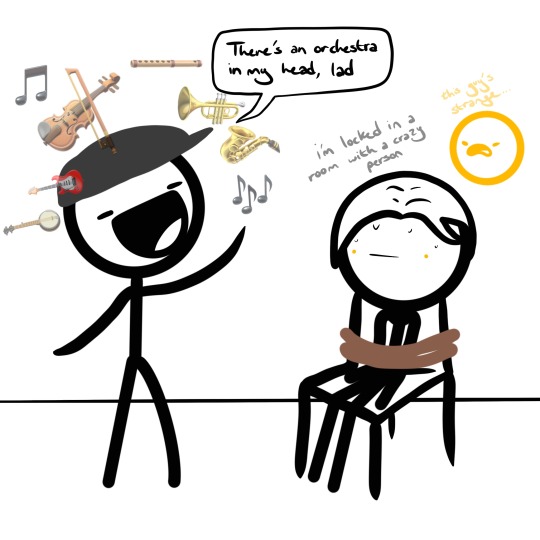
AN. EPISODE. 🎸🪕🎻🪈🎺🎷🪘🥁🪇
#Malevolent#Malevolent Podcast#WHYYYYYYYYYYYYY#Okay but like real talk can we applaud Harlan for this ep? Bc it’s beautiful#The first like POV shift we’ve had#And it was very cool#But also kinda disorienting bc John does help me see the surroundings better but Mr. Collins here doesn’t have a John#He just has his orchestra#When he was mentioning working usually in pianissimo but using fortissimo this one time that was SO dang clever#And it makes sense why he uses the piano wire usually.. so he can hear his orchestra crystal clear#It was very good writing#But as the ep went on.. ESPECIALLY after he killed the cops whenever Peggy Gordon played I flinched#I heard one 🎵 and then AAAAAAAAAAAAAAA#Evil song#But it sucks I’m scared of it and now it’s stuck in my head 😑#Anyway the conversation between Arthur and Butcher was interesting#This ep really makes you realize how Arthur is on the outside; how all those taxi drivers and clients see him#Idk why it’s fun when Collins brings up his eyes#And the big thing#LARSON IS COMMMMMMIIIINNNNGGGGGGGGG#LET’S BEAT HIM UP FINALLY PLZZZZZ#AND LIKE OH MY GOD DON’T KILL DANIEL PLEASE BUTCHER#JEEZ HEARING ARTHUR PLEADING BEHIND THE DOOR NEARLY MADE ME CRY HE’S SO DESPERATEEEEEEEEE#HE CAN’T LOSE HIS ONLY FAMILY#And then it ends how it began: 🎵🪇🥁🎸🪗🎺🎷🪘🪕🪈🎶#This podcast is so gooooooooood
69 notes
·
View notes
Text
the next time i get messaged, "when are you updating [fancomic]" without even so much of a compliment im going to start killing.
#i turned off asks on my fancomic blog and ppl will just go to my fandom main to annoy me 😐#like. okay! even a 'hey i luv ur webcomic is this still active' would be 80% less annoying 😑#Still Annoying. but less#ive made a post like this before but why do ppl who never comment on ur comic. compliment it. share it at all. be the most entitled#txt#thank god for traversion bc (HOPEFULLY) no one will annoy me like this if i dont update every week
23 notes
·
View notes
Text

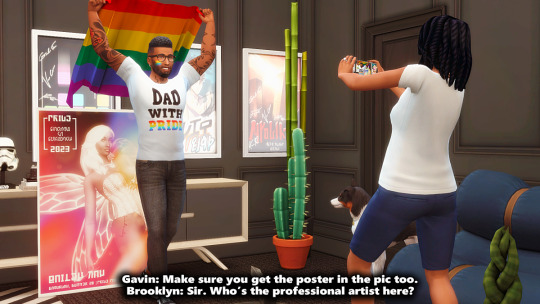


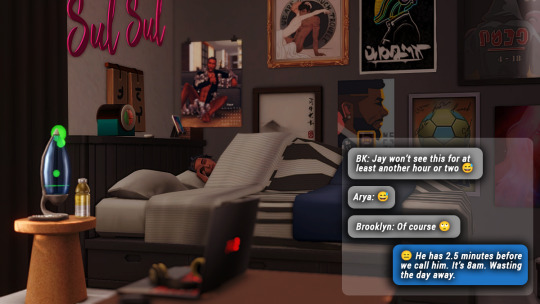




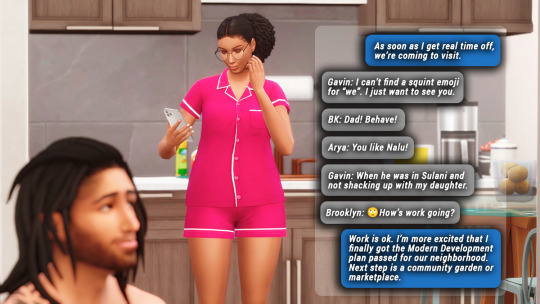


Check In with the Richards - Around the Globe Edition
-
One more message, not in the group chat...

#circle of trust#richards gang gang#family group chat updates#brooklyn and gavin both don't believe in sleeping late#😑#q said i'm not getting in trouble again#don't know why the richards women freak out over marriage#just a bunch of anxious arethas#bklegacy#bklgen2#gavin richards#brooklyn kay#bailey kay#quinton#jayce's journey#jayce#arya's adventures#arya#nalu#globetrotter tings
74 notes
·
View notes
Text
what exactly compels people to insult fics in PUBLIC bookmarks??
like sir, the writer is a random person who's writing for fun and has decided to share their creation with us so that hopefully some of us can have a few minutes of joy in our day!! that's amazing!
if you don't like it - just click out. it's not like they tricked you into giving them your firstborn, chill out and be respectful.
#'this fic is soooo mid 😑 and i dont like this trope!!'#it's literally tagged?? like... they told you it'd be the main trope. what more do you need?#if you want to be rude put that shit into the private bookmarks dude#BUT ALSO WHY THE FUCK ARE YOU BOOKMARKING FICS YOU DON'T LIKE??#and it even looked like they were aiming the bookmark at other readers?? like 'oh beware this fic is shit'#shut the fuck up?? first of all no it's not. second of all how dare you?? that's a fan just like you!#ao3#ao3 fanfic#mcu#percy jackson#kinnporsche the series#mdzs#spn#destiel#hannigram#merthur#percabeth#wangxian#six of crows#johnlock#found family#art#xiyao#steddie#stranger things#doctor who#tgcf#hualian#bakudeku#pjo
53 notes
·
View notes